The Continental Edison QLED 55 Android TV is one of the cheapest “QLED” branded LCD TVs on the market. And like the Samsung QE65Q60R which has already gone through the lab, it really has only QLED in name. Explanations …

Presentation
The Continental Edison QLED 55 Android TV has a 55-inch (approximately 140 cm) VA LCD panel displaying an Ultra HD definition of 3840 x 2160 px using a quantum dot filter, which allows it to inherit the name from QLED. This panel is not necessarily manufactured by Samsung since TCL, for example, sells televisions stamped “QLED” using its own panels. In addition, other manufacturers sell televisions equipped with identical filters without using the term QLED (for Quantum-Dot LED). This is the case of Sony with its Triluminos process, or of Philips with its Quantum Dot 4K LED televisions. Remember also that QLED is not a technology like OLED,
Coming back to this TV, the manufacturer announces a contrast of 3000: 1, reduced viewing angles of 160 ° and compatibility with HDR10. This very affordable model comes with Android TV in version 9.0 and even has a remote control with an integrated microphone, which is very practical for voice searches and making the most of the capabilities of this television. For the rest, you have to make do with a 2 x 10 W audio system and a simple TNT and cable tuner (DVB-T / 1 and DVB-C).
The Continental Edison QLED 55 Android TV – the exact reference we tested is CEQLED55SA20B7 – is currently sold for around € 450 by Cdiscount, making it a direct competitor to the Samsung UE55TU7125 and the TCL 55EP680 .
Technical Sheet of Continental Edison QLED 55 Android TV
| Diagonal | 55 inch |
| Definition (pixels) | 3840 x 2160 pixels |
| HD compatibility (1080i / 720p) | 2160p / 1080p / 720p |
| HD Ready Certification | Yes |
| Viewing angles (H + V) | 178/178 |
| Sound power | 2 x 10 W |
Image quality
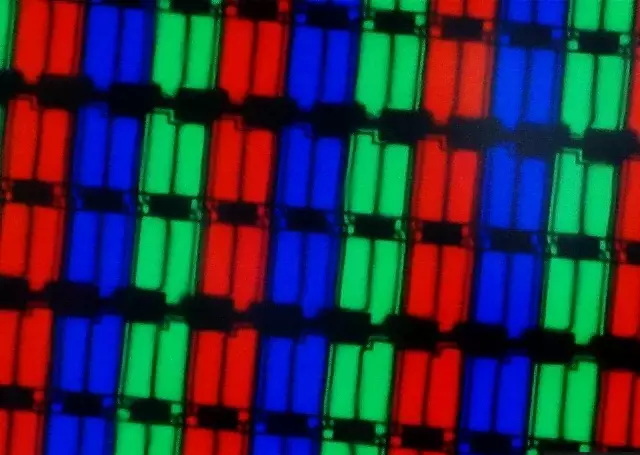
This television makes good use of a VA (Vertical Alignment) type LCD panel. This display technology achieves good contrast by effectively blocking backlight light. On the other hand, the viewing angles are narrower than on an IPS or OLED LCD television. No surprise on this side since we measured a 70% variation in brightness at 45 °, which is as much as on other VA televisions. Only very high-end models equipped with an optical filter improving viewing angles ( Samsung QE85Q85R / QE65Q90R or Sony 65XH9505 ) normally manage to improve the viewing angles of a VA panel. In any case, it is very far from what Oled technology offers, with only 25% variation at 45 °.

Delta E = 9.6 | 2/5
If it is usually the Film or Cinema mode which gives the best rendering, this is not the case on this Continental Edison television where the most faithful colors – so to speak – are displayed in standard mode. In this mode, we measured a Delta E of 9.6, therefore much greater than 3, threshold above which the human eye perceives the colorimetric drift. The colors displayed are thus far from being faithful to those sent by the source.
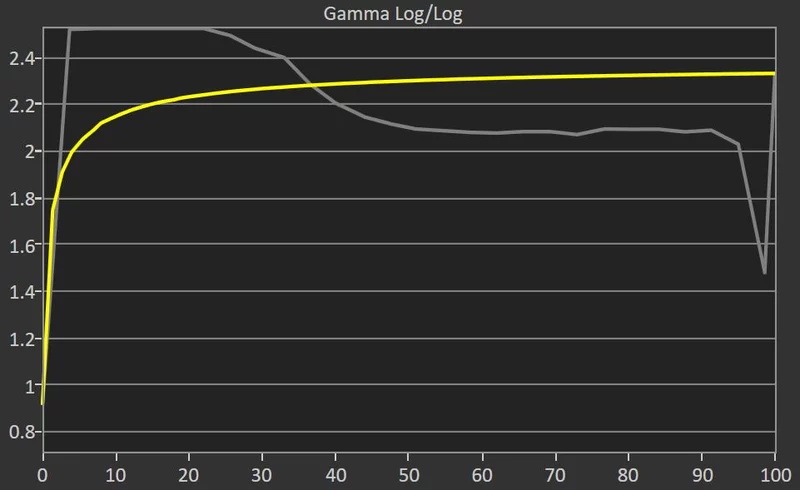
2.26 | 3/5
If the mean of the gamma measured at 2.26 is correct, the gamma curve lacks stability, which is reflected in the image by underexposed dark grays and, conversely, overexposed light grays. It’s just average.
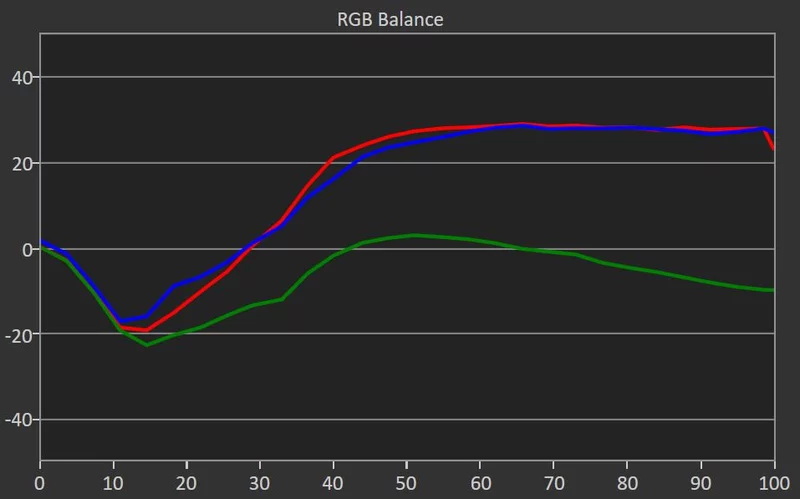
7,200 K | 3/5
The same goes for the color temperature. By choosing a setting on hot, the temperature remains too high (7200 K) compared to the video standard (6500 K). Yet the rendering to the image is not as cold as the curve suggests, since there is as much blue as there is red. Strangely, in the image, the temperature seems too hot and draws red. Overall very average.

4080: 1 | 5/5
VA LCD technology achieves very good native contrast, measured at 4080: 1 and excellent for an LCD television. This contrast ratio makes it possible to display deep blacks, even in complete black. On this point, this Continental Edison television teases the best LCD models, such as the Samsung QE65Q70R or the Sony KD-85ZG9 . Obviously, it cannot compete with the Oled models, whose contrast is considered infinite.


The scaling engine allows you to resize SD, HD and Full HD content so that they are displayed correctly on this Ultra HD panel. This engine is pretty basic and produces a pretty blurry and very smooth image. Fortunately, it does not distort the original source and limits artifacts.
This television does not embed a motion compensation engine or process for inserting images to deceive retinal persistence. Objects in motion on a light background therefore appear rather blurry due to the low reactivity of the screen.
HDR
The Continental Edison TV is only compatible with HDR10. The manufacturer does not mention HLG compatibility – the HDR format used by television – and even less compatibility with the dynamic metadata formats HDR10 + and Dolby Vision, which are however very useful on entry-level televisions.
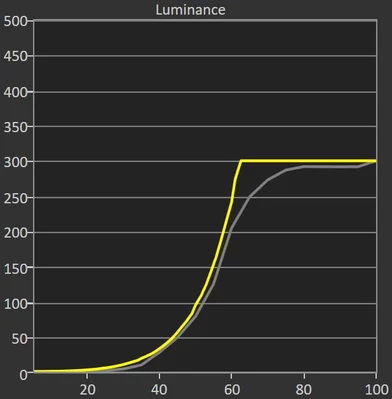
299 cd / m² | 2/5
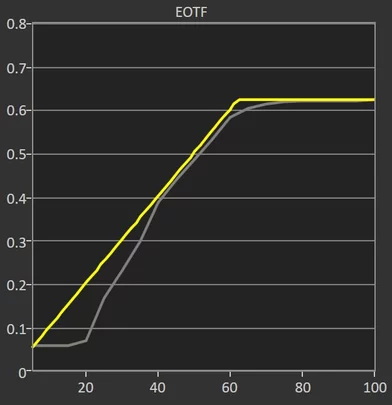
4/5
The Display Tone Mapping used by Continental Edison has a little trouble following the reference curve at the bottom of the spectrum, but we find the expected behavior from 40% luminance. The television even allows itself to smooth the signal up to its maximum capacity in order to avoid the phenomenon of clipping with an HDR10 signal at 10,000 cd / m² used for this test. However, the maximum brightness is very limited since we measured the peak brightness at 299 cd / m², a value too low to fully benefit from the dynamics of HDR content. Fortunately, the Continental Edison QLED 55 makes up for it with a good black level, but it cannot display the dynamics of very bright images.

Delta E = 11 | 2/5
By default, the standard HDR mode displays a Delta E greater than 11. Even by adjusting the settings and deactivating many options, it is impossible to obtain more accurate colors. In HDR, therefore, the colors cannot be considered fair.
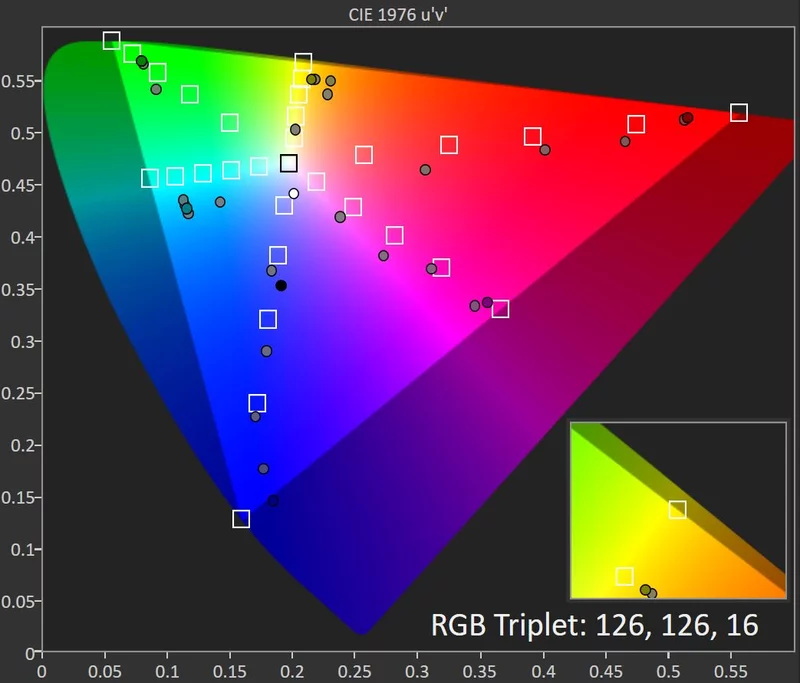
71% | 3/5
The good surprise comes from the coverage of the Rec.2020 space since the QLED 55 Android TV manages to reproduce 71% of the colors of this space. It rises to the level of high-end models: Oled models currently display between 70 and 75% of Rec. 2020, and the television offering the best coverage is the TCL 65C815 with 76% of Rec . 2020 . Still, this good coverage of Rec. 2020 is of little use with poor factory calibration, since the colors displayed are rarely those requested.

86% | 4/5
With 86%, the coverage of the DCI-P3 space is also good and makes it possible to reproduce a good part of the colors of this space which is still today mainly used for 4K Ultra HD productions. On the other hand, we find the same problem of color fidelity which makes this good coverage almost obsolete.
Video games
Fortunately, the Continental Edison television makes up for it with a display delay measured at 31 ms, whatever the chosen picture mode, proof that there is no video processing. This delay results in less than two images behind the source (at 60 Hz). The lag between the action performed on the controller and its repercussion on the screen is therefore reduced and has little impact on the gameplay.
Switching to Game mode results in the display of fanciful colors, with an average Delta E measured at 13 in SDR and 17 in HDR. The easiest way is to stay in Standard mode, which offers the same display delay with an average Delta E of only 11 in HDR.
Clouding

The use of a Direct Led backlighting system limits the risk of clouding , but this defect can appear if the light distribution filter is damaged during transport. We didn’t see any clouding issues on the model we tested or light leaks in the corners. However, we have identified a drop in brightness in all four corners of the image.
We measured the average difference in homogeneity of the white over the entire slab at 14%; a good number for a 55 inch LCD model. Remember that above 20%, the eye begins to perceive a difference in uniformity.
Design and usage
The Continental Edison QLED 55 television has a fairly classic design, versatile, flawless note. The TV surround is in shiny black plastic while the feet are in imitation aluminum metal. The bezel around the screen isn’t particularly thin, but it’s far from coarse. More interestingly, the finishes are good for a television in this price range and the assembly is well done.

The treatment of the panel is not really effective against reflections. This entry-level TV is logically quite far from Samsung’s premium models – real references on this criterion -, and it does not equal the OLED models either. It is on the same level as the entry level Samsung UE55TU7125 and 55TU8005 TVs .
In profile, the Continental Edison QLED 55 isn’t exactly thin, but that doesn’t really matter. The bulk on the TV cabinet is in any case always linked to that of the feet. You should expect a depth of 26.9 cm and a spacing of 117 cm between the feet. This TV is therefore perfectly at home on our reference TV cabinet (160 x 40 cm).

The rear is very classic. Black plastic is basic. We find the power supply on the left and the connectors on the right, facing downwards and to the side. The TV is compatible with wall mounts to VESA 400 x 200 mm.
For an entry-level television, the connection is rather complete and well supplied. There are thus four HDMI 2.0b inputs (HDCP 2.2 and HDR), three USB 2.0 ports, an optical digital audio output, an Ethernet port, a headphone output, a PCMCIA port (Common Interface CI +), as well as the TNT / antenna socket. cable. This model has a DVB-T / T2 / C tuner, as well as Wi-Fi and Bluetooth.

The Continental Edison QLED 55 television is powered by Android TV in version (9.0). This system uses the new interface introduced by Android 8.0. It is a little less intuitive at first, but turns out to be more effective later. The lines directly display the content of the most used apps (Netflix, YouTube, Molotov TV, myCanal, SFR Sport, etc.). The Android TV system is one of the most complete on the market and, above all, the one that offers the most apps, but not all of them are optimized for TV use. The version carried by Continental Edison is particularly sober. We do not find the host of preinstalled applications from other manufacturers, even if we still find the essential Netflix and Amazon Prime Video in addition to Google applications (YouTube, Google Music and Google Movies). As with all Android TVs, the Chromecast built-in lets you receive and display a video stream sent from a smartphone, tablet or computer. Surprisingly, the system is smooth on this entry-level TV, which is far from the case with all products in this price range. Android TV is powered by an ARM Cortex-A55 Quad Core processor with GU Mali 470MP3, 8 GB of eMMC and 1.5 GB of RAM.
As with all Android TVs, the first start takes longer. It takes about 38 s here. Fortunately, the television wakes up in 5 s, while consuming less than 1 W in standby. Either way, it’s much longer than Samsung’s Tizen or LG’s WebOS systems, which boot in less than 5s. Finally, as often, the standby is instantaneous.
Despite its affordable price, this TV comes with a complete remote control incorporating a microphone. It is rather pleasant to use. The buttons fall naturally under the thumb and are easily accessible. Above all, it has an integrated microphone, essential for making the most of the connected functions, in particular for carrying out searches on YouTube or via Google Assistant.

Audio
The audio system consists of two 10 W speakers, which are not at the expected level. Sound is clearly not the strong point of this TV. The frequency response is only ensured correctly between 170 and 2000 Hz. The rendering is metallic, lacks bass and precision. In short, with this television even more than with others, we will advise you to opt for a sound bar, a home cinema kit or even a PC speaker kit to connect to the headphone output.

Consumption
We measured the consumption at 65 W on our test chart with a white set at 150 cd / m², ie a relative consumption of only 78 W / m², much lower than the average of the televisions tested (around 100 W / m²). While this model does not directly compete with the most energy efficient TVs, such as the Sony 65XH9096 (60.1 W / m²), the TCL 55DC760 (66 W / m²), or the Sony KD-55XH8096 – the most economical of our comparison – which is satisfied with a consumption of 55 W / m², it is still one of the very good students. Standby consumption is always less than 1 W.
Our settings and measures
Standard mode provides the best picture quality – so to speak. You can then play with the color temperature by reducing the red and blue tints to get a more neutral image.
| COLUMN 1 | COLUMN 2 |
|---|---|
| Real contrast | 4,080: 1 |
| Black | 0.04 cd / m² |
| Gamma quality | 3/5 |
| Delta E | 9.6 |
| Slab homogeneity deviation | 14% |
| Viewing angles | 3/5 |
| Consumption | 65 W |
Continental Edison QLED 55 Android TV – Conclusion
As we had already seen during the Samsung QE65Q60R test , not all QLED TVs are created equal and entry-level models like this Continental Edison QLED 55 do not do better than other “non-QLED” TVs sold at the same. price. If for this price the Continental Edison still offers a convincing Android TV experience thanks to the microphone on the remote control and a certain fluidity of the whole, the image quality is unfortunately not there. It is better to turn to the TCL 55EP680 which offers an image worthy of the name for a close price.
Positives of Continental Edison QLED 55 Android TV
- Contrast.
- The possibilities offered by Android TV.
- Remote control with microphone.
Negatives of Continental Edison QLED 55 Android TV
- Why is it called “Qled”?
- Calibration largely perfectible.
- No interest in HDR content.
- High afterglow time.
- Audio part to review.

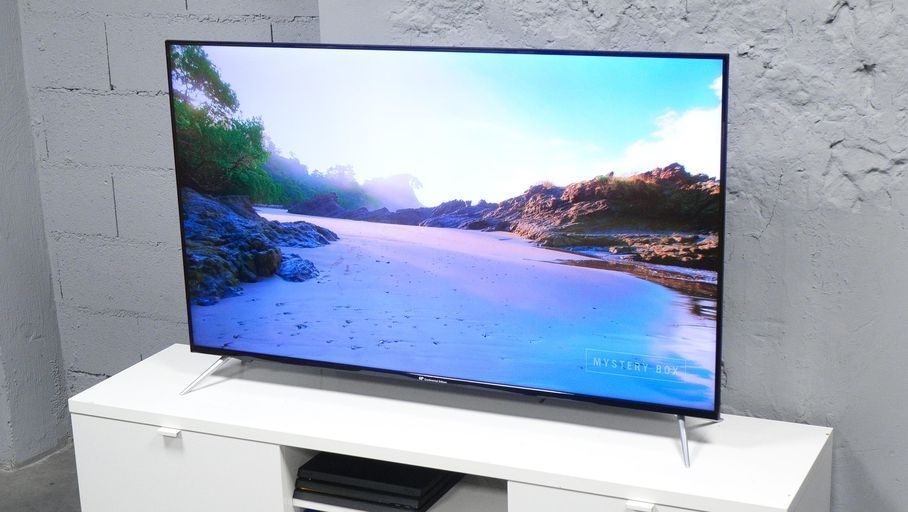



Add Comment